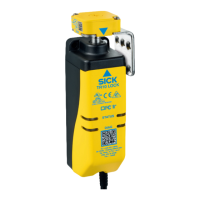4.3.1 Measures against accidental damage
You can use the following measures to avoid unintentional damage to the safety switch:
•
Select the mounting location so that the safety switch is protected from impacts
and mechanical pressure.
•
Fit an additional stop for the door. The safety switch must not be used as a stop.
4.3.2 Measures against manipulation
The safety switch must not be defeated (contacts jumpered), rotated away, removed, or
rendered ineffective in any other way. You must put measures in place, if necessary, to
reduce the possibilities for circumventing the device.
4.4 Integrating into the electrical control
Switch-on commands which bring about a dangerous state of the machine must not be
enabled until the protective device is closed and the lock is activated. The lock must not
be deactivated until the dangerous state has ended. Depending on the safety concept,
the signal is analyzed by, e.g., safety relays or a safety controller.
The connected controller and all devices responsible for safety must comply with
the required performance level and the required category (for example according to
ISO13849-1).
4.4.1 Lock
The logic to generate a locking command with the control changes depending on the
product variant selected.
Variant according to “power to release” principle
To lock, make sure there is no voltage at the “lock input” contact (locking command
active).
To unlock, apply 24VDC voltage at the “lock input” contact (locking command inac‐
tive).
For variants based on the power to lock principle
To lock, apply 24VDC voltage at the “lock input” contact (locking command active).
To unlock, make sure there is no voltage at the “lock input” contact (locking command
inactive).
4.4.2 OSSDs
Safety locking devices with local inputs and outputs can be directly integrated into the
machine controller.
DANGER
Hazard due to lack of effectiveness of the protective device
In the case of non-compliance, it is possible that the dangerous state of the machine
may not be stopped or not stopped in a timely manner.
b
Make sure that the following control and electrical requirements are met so the
protective function can be fulfilled.
•
The output signals from an OSSD pair must not be connected to each other.
•
In the machine controller, both signals from an OSSD pair must be processed
separately.
4 PROJECT PLANNING
16
O P E R A T I N G I N S T R U C T I O N S | TR10 Lock 8019972/1CS1/2022-07-20 | SICK
Subject to change without notice

